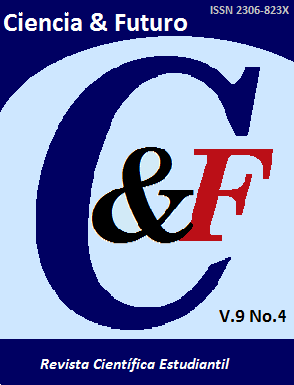Post welding heat treatment of a nodular iron
Keywords:
hypoeutectic casting, thermal cycle, welded jointAbstract
The post-welding heat treatment of a welded nodular iron with electrodes E 316L-16 and UTP 65 was performed. Welded samples that were subjected to austenitized heat treatment in a muffle furnace were selected with temperatures of 900 ° C, followed by forced cooling from 780° C to 650° C and then with air cooling reducing the austenite content in the weld foundry matrix. When determining the type of solidification of the nodular cast iron, it was found that it solidifies as a hypoeutectic cast iron; characterized by the carbon content. It was determined that hardness increased from HV 250 to HV 344.5 after applying the thermal welding cycle in the different areas of the welded joint; after austenitized, it had a decrease from HV 344, 5 to HV 230 with electrode E 316L-16 and from HV 324.5 to HV 227.5 in the same areas which demonstrates the residual stresses decreasing in the welded joint.Downloads
References
AGUILAR, R. 2012. “Introducción a la Metalurgia”, Curso Básico para Ingenieros. Proyecto de investigaciones metalúrgicas. Universidad de San Carlos de Guatemala.
AL-GHONAMY, I.; RAMADAN, M.; FATHY, N.; HAFEZ, M.; EL- WAKIL, A. 2012. Effect of graphite nodularity on mechanical properties of ductile iron for waterworks fittings and accessories. International Journal of Civil & Environmental Engineering 10(3): 1-5.
ASM INTERNATIONAL. 2005. Welding brazing and soldering. Metals handbook, Metals Park. ASM International. Ohio, 6: 2873.
CEMBRERO, J. & PASCUAL, M. 1999. Soldabilidad de las fundiciones de grafito esferoidal. Revista de metalurgia 35(6): 392-401.
DASGUTA, K.; MONDAL, K.; CHAKRABARTI, K. & GANGULI, C. 2011. Microstructure and mechanical properties of as cast ductile irons alloyed with manganese and copper. Journal of Materials Engineering and Performance 21(8): 1728-1736.
FERNÁNDEZ, T.; RODRÍGUEZ, I. & ALCÁNTARA, D. 2017. Procesos Metalúrgicos y tecnológicos de la soldadura. Editorial Academica Española.
FERNÁNDEZ, T.; RODRÍGUEZ, I.; CORREA, R. & ALCÁNTARA, D. 2014. Junta de soldadura disímil de la aleación HK–40 y del hierro fundido 24. Ingeniería Mecánica 17(2): 98-107.
KOVACS, B. 1990. Austempered Ductile Iron: Fact and Fiction. Mod. Cast. 80(3): 38-41.
LIN, S.; PAN, J.; WUNG, P.; CHIANG, J. 2006. A fatigue crack growth model for spot welds under cyclic loading conditions. International Journal of Fatigue 28: 792-803.
SOHI, M.; AHMADABADI, M.; VAHDAT, A. & AMIRSADEGHI, A. 2010. Evaluation of the role of alloying elements in austemperability of heavy section ductile iron. Advanced Materials Research 83-86: 481-487.
VAN BOHEMEN, S. 2013. The nonlinear latice expansion of iron alloys in the range 100-1600 K. Scripta Materialia 69(4): 315-318.
Published
How to Cite
Issue
Section
Copyright (c) 2019 David Hernández-Sanamé

This work is licensed under a Creative Commons Attribution-NonCommercial 4.0 International License.
Esta obra está bajo una Licencia Creative Commons Reconocimiento-NoComercial 4.0 Internacional
La Revista Ciencia & Futuro es una revista de acceso abierto, todo el contenido está disponible gratuitamente sin cargo para el usuario o su institución. Los usuarios pueden leer, descargar, copiar, distribuir, imprimir, buscar o vincular los textos completos de los artículos, o utilizarlos para cualquier otro fin lícito, sin pedir permiso previo al editor o al autor. Todo lo anterior, de acuerdo con la definición de BOAI de acceso abierto.
Los autores que publican en esta revista están de acuerdo con los siguientes términos: Licencia Creative Commons Atribución-NoComercial permite que el beneficiario de la licencia tenga el derecho de copiar, distribuir, exhibir y representar la obra y hacer obras derivadas para fines no comerciales siempre y cuando reconozca y cite la obra de la forma especificada por el autor o el licenciante. Los autores pueden establecer por separado acuerdos adicionales para la distribución no exclusiva de la versión de la obra publicada en la revista (por ejemplo, situarlo en un repositorio institucional o publicarlo en un libro), con un reconocimiento de su publicación inicial en esta revista. Se permite y se anima a los autores a difundir sus trabajos electrónicamente (por ejemplo, en repositorios institucionales o en su propio sitio web) antes y durante el proceso de envío, ya que puede dar lugar a intercambios productivos, así como a una citación más temprana y mayor de los trabajos publicados (Véase The Effect of Open Access) (en inglés). Lo anterior debe realizarse siempre sobre el artículo ya publicado por Ciencia & Futuro.
Los autores mantienen el control sobre la integridad de sus trabajos y el derecho a ser adecuadamente reconocidos y citados.
A los editores se les otorgan derechos no exclusivos para publicar y distribuir.







